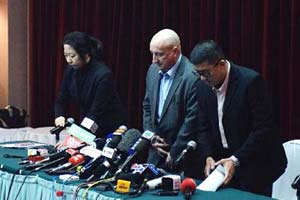Possible clue in missing plane mystery
By Zhang Lei and He Na (China Daily) Updated: 2014-03-10 01:20He attended an internal meeting of Malaysian authorities and was told that in the event of a failure of the electronic systems or engines, the aircraft would still have been able to send out a distress signal and even if the signal system crashed, electronic positioning sensors would still function.
The FBI sent agents and technical experts to assist in the inquiries. US officials told the Los Angeles Times that they were trying to determine if there was any link with terrorist activity, but stressed that no evidence had yet been found to support that theory.
"Just because they (the passports) were stolen doesn’t mean the travelers were terrorists," according to an official from the US Department of Homeland Security, interviewed by the newspaper. "They may have been nothing more than thieves. Or they could have simply bought the passports on the black market," he added.
The two passengers were caught on closed-circuit television at Kuala Lumpur International Airport, and the footage would be studied closely as part of the investigation, said Datuk Azharuddin Abdul Rahman.
Although the possibility of finding survivors is slim, the search and rescue teams have spared no efforts. China dispatched naval vessels, the frigate Mianyang and the amphibious landing ship Jinggangshan, according to PLA navy sources. Mianyang was expected to reach the search area by 7:30 am on Monday, while Jinggangshan is scheduled to arrive by 10 am Tuesday.
Jinggangshan sailed from Zhanjiang port in South China’s Guangdong province at 3 am on Sunday. In addition to 14 medical professionals and 10 rescue divers, the ship was carrying life-saving equipment, underwater detection monitors and supplies of oil, water and food. It is also equipped with two helicopters, speedboats and 52 marines.
Mianyang was on a mission in the waters close to the Nansha Islands in the South China Sea before being dispatched to the search and rescue zone at 11:50 pm on Saturday. Wu Shengli, commander-in-chief of the PLA navy, responded quickly to the news of the lost plane and ordered the South China Sea Fleet to prepare for the rescue mission.
Yan Kai, a senior engineer of China’s manned deep-sea submersible research vessel Jiaolong, said poor infrastructure in the Nansha islands had hampered the search and rescue operation.
"The suspected accident site is close to other Nansha islands, but neither a port nor an airport is available there," he said. "Actually in the whole of Sansha city, that governs the Xisha, Zhongsha and Nansha islands and their surrounding waters, there are only one small airport and one port."
Experts and aviation industry insiders were puzzled by the length of time MH370 has been missing. Zhao Yifei, professor of Air Traffic Management Institute at the Civil Aviation University of China, said taking off and landing are two most dangerous parts of any flight. The chances of a fatal incident occurring when the aircraft is at cruising altitude are remote.
"In my experience, among all the possible causes of an aircraft going missing or crashing, I think only one thing is certain — whatever happened occurred so quickly that it left the pilots with no time to place a distress call," said Zhao.
"I think there’s a high possibility that mechanical failure resulted in the aircraft entering the wrong air layer where the weather conditions were extreme. The fact that the aircraft’s signal disappeared so suddenly indicates that, with the exception of a terrorist attack, it could be that the plane was hit by a thunderstorm or other strong forces, such as extreme hail," he said.
Zhao suggested that the aircraft might have broken up in mid-air, or a loss of control may have sent it plunging it the ocean intact. "I think the possibility that the aircraft is already deep in the water is also quite high. The rescue workers may find some floating debris and seats, but the larger parts of the aircraft may take longer to find," he said.
A senior official from a Chinese airline, who declined to be identified, offered contrasting scenarios. "I think the possibility that the fight was hijacked and the signal was turned off manually is also quite high. It may have landed somewhere not far from where the signal was lost and the passengers may be safe temporarily," he said. "But the pessimistic point of view, even though we hope it didn’t happen, is that an electrical system malfunctioned and suddenly cut off all the power, leading the plane to crash into the ocean."
The official said severely adverse weather conditions could also have caused the disappearance. Although aircraft are designed to fly through severe storms, abrupt changes in the complicated upper-air weather systems are extremely difficult to predict and respond to, he added.
Gao Yuanyang, director of the General Aviation Industry Research Center at Beihang University in Beijing, said that although the aircraft had been in service for about 12 years, that didn’t mean it was old and prone to technical problems.
"It’s very likely that the plane broke up in mid-air. That would explain the sudden loss of contact. When contingencies such as heavy thunderstorms happen, the captain will usually activate the rescue system, and have time to contact the air traffic control tower or the airspace management department, therefore something extremely unexpected must have happened to this plane, and all further analysis depends on locating the exact point where it went down," he said.
However, according to Mei Dongmu, an aircraft designer at the Aviation Industry Corporation of China, adverse weather was unlikely to be the cause of the plane’s disappearance. "It’s quite common for a plane to be caught in turbulence, something that’s essentially unpredictable. And in the overwhelming majority of cases, the pilot, after sensing the instability in the plane’s movement, would simply get out of harm’s way by gaining altitude or bypassing the center of the turbulence," he said.
"But of course there are rare occasions when due to a number of reasons — the pilots taking scheduled sleep breaks, for example — the threat of bad weather is noticed too late, and the plane, out of control, plunges headlong toward the ground, or, as has been speculated in this instance, the ocean," he added.
Unlike Zhao, Mei believed the plane should have been easy to find. "If it did indeed plunge into the ocean, then it would be almost impossible for us not to find it. It’s a common misconception that a crashed plane is bound to sink to the bottom of the sea — in reality, the cylindrical fuselage would almost certainly float on the surface of the water for some time, even if it had broken into two or three sections," he said. "And all the other stuff — chairs, cushions, plastic bags, for example — would eventually form a little island of wreckage carried by the waves. We have found nothing like that so far," he said.
"So, in my view, the plane didn’t fall into the ocean or onto the ground. It simply exploded mid-air, the metal shell breaking into a million pieces that can no longer be identified. The bodies of the victims have probably fallen into the ocean, and it might take days for them to resurface," he said. "I know it’s the bleakest picture possible and something we are all very reluctant to believe, but it’s my honest opinion," he said.
Mei offered two possible reasons for an explosion. "One is metal fatigue: The plane has been in service for 12 years and may have needed an overhaul at Boeing’s headquarters in the United States. I’m not sure about the condition and the maintenance of the aircraft, but there’s a possibility that it had been overused, which could have led to an explosion," he said. "It’s very much like hammering a piece of reinforced glass that has that kind of 'fatigue’ — the glass just cracks into powder. If a plane reaches that state, almost anything could prove to be the last straw."
The other possible reason is terrorism. "If terrorists had detonated dynamite on the plane, it would just explode and vanish," he said.
Captain John M. Cox, CEO of Safety Operating Systems, was a pilot for US Airways for 25 years. He said that whatever happened to the Malaysia Airlines jet, it happened quickly. The problem had to be big enough to stop the plane’s transponder from broadcasting its location, although the transponder can be deliberately closed down from the cockpit, he said.
One of the first indicators of what happened will be the radius of the field of debris. If it is large and spread over a wide area, the plane probably broke apart at high altitude, which may indicate a bomb or a massive failure of the airframe. If the debris field is limited, the plane was probably intact and fell from 10,000-plus meters before breaking up on contact with the water.
"We know the airplane is down. Beyond that, we don’t know a whole lot," Cox said.
Contact the writers at zhanglei@chinadaily.com.cn and hena@chinadaily.com.cn
Zhao Xu, Hou Liqiang, Xu Wei, Wang Wen, Zhao Shengnan, Zhao Yinan, Cui Jia and Zhang Yan contributed to this story.
|
 |
 |
| Malaysia Airlines holds press conference |
Missing plane may have turned back: official
The missing Malaysian jet may have turned back from its scheduled course to Beijing before disappearing, a military official said here Sunday.
2 passengers with false passports aboard missing plane
Two passengers with false passports got on board the missing Malaysian plane according to the closed-circuit television (CCTV) records, Malaysian Department of Civil Aviation Director General Azharuddin Abdul Rahman confirmed Sunday in a latest press conference.
Chinese rescue force reaches suspected site of missing plane
A Chinese coast guard vessel has entered the waters around the suspected site of the missing Malaysian plane to carry out a rescue mission. As of 11:30 am on Sunday, the vessel "China Coast Guard 3411" has entered the area and was about 45 nautical miles from where the plane was believed to be when it lost contact with ground control, according to China's State Oceanic Administration.
Malaysia Airline plane that went missing over Vietnam on Saturday has still not been located, said Li Jiaxiang, director of Civil Aviation Administration, China. China has dispatched a large team, including marine forces, to help in the search for the aircraft that was carrying 239 people, including 154 Chinese.




